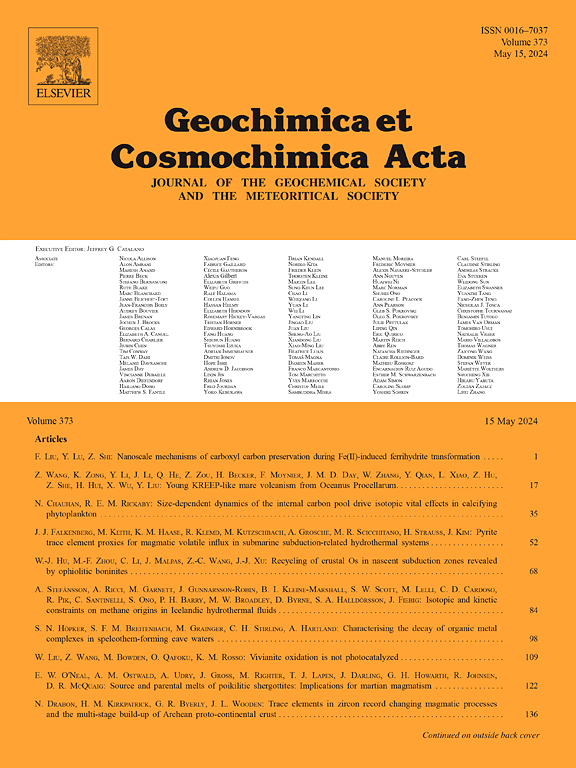Moderately volatile elements in chondrites record chondrule formation, two-component mixing and redistribution on parent bodies
IF 4.5
1区 地球科学
Q1 GEOCHEMISTRY & GEOPHYSICS
引用次数: 0
Abstract
Most chondrites are depleted in moderately volatile elements (MVE) relative to the bulk solar system composition represented by CI chondrites. Here we present high-precision isotope dilution data for 11 moderately volatile elements (S, Cu, Zn, Ga, Se, Ag, Cd, In, Sn, Te and Tl) together with Cd and Zn stable isotope compositions for carbonaceous, ordinary, enstatite and Rumuruti chondrites complemented by a literature compilation of MVE stable isotope compositions. Together these data allow new insights into the processes that led to MVE depletion in chondrites and their redistribution within parent bodies.
Moderately volatile element abundances in carbonaceous, ordinary and Rumuruti chondrites are best explained by two-component mixing between a chemically CI-like MVE-rich matrix and an MVE-poor refractory component dominated by chondrules. Chondrules are enriched in light MVE isotopes due to kinetic recondensation of a small vapor fraction initially lost from chondrules upon heating. Later, thermal metamorphism redistributed some MVE within chondrite parent bodies, which is evaluated here in a systematic way for different chondrite groups and plateau volatile elements based on related and comparatively large but unsystematic stable isotope fractionation. Compared to other chondrite classes, enstatite chondrites show less systematic MVE abundance patterns when the elements are plotted as a function of condensation temperatures. Type 3 and 4 enstatite chondrites are more MVE-rich than expected based on their low matrix fractions and are enriched in light Zn and Te isotopes relative to CI. The enrichment of light Zn and Te isotopes and high MVE abundances in type 3 and 4 enstatite chondrites relative to CI can be explained by recondensation of a larger MVE vapor fraction after chondrule formation than observed for other chondrite classes, which presumably occurred at comparatively high H2 pressures. Because MVE abundances and isotope compositions are fully consistent with chondrule formation, two-component mixing and MVE redistribution on parent bodies, we refute partial condensation from a hot solar nebula as the cause for MVE depletion in chondrite formation regions of the protoplanetary disk.
求助全文
约1分钟内获得全文
求助全文
来源期刊

Geochimica et Cosmochimica Acta
地学-地球化学与地球物理
CiteScore
9.60
自引率
14.00%
发文量
437
审稿时长
6 months
期刊介绍:
Geochimica et Cosmochimica Acta publishes research papers in a wide range of subjects in terrestrial geochemistry, meteoritics, and planetary geochemistry. The scope of the journal includes:
1). Physical chemistry of gases, aqueous solutions, glasses, and crystalline solids
2). Igneous and metamorphic petrology
3). Chemical processes in the atmosphere, hydrosphere, biosphere, and lithosphere of the Earth
4). Organic geochemistry
5). Isotope geochemistry
6). Meteoritics and meteorite impacts
7). Lunar science; and
8). Planetary geochemistry.
 求助内容:
求助内容: 应助结果提醒方式:
应助结果提醒方式:


